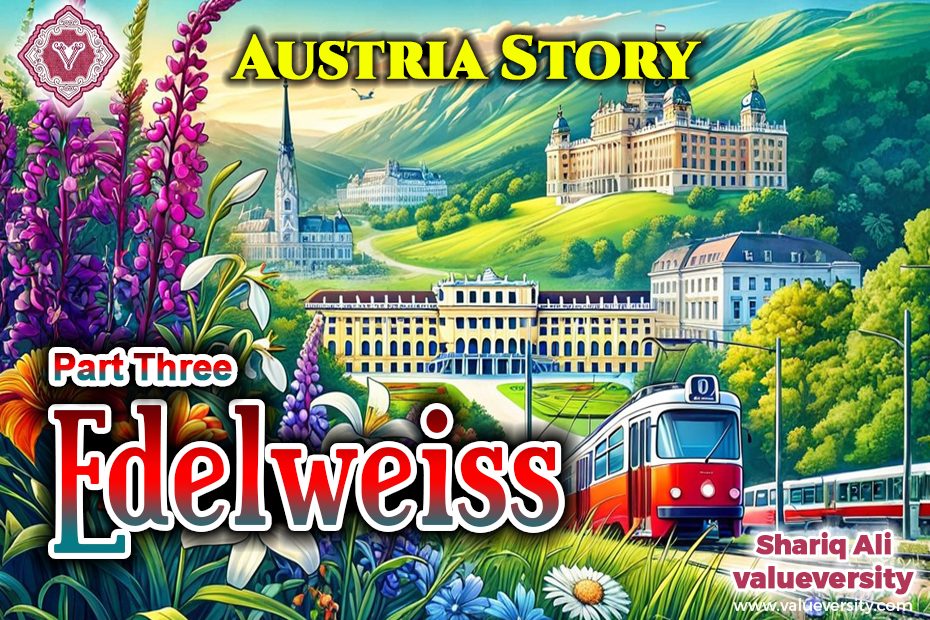Episode 3
Shariq Ali
Valueversity
The train stopped at the Hietzing station, the electric doors opened, and we both stepped onto the platform. It was moderately crowded. We had barely walked a few steps toward the exit gates when a middle-aged man with Asian features stopped us. He was distributing magazines for free. Since we were unfamiliar with the local language, we politely returned the magazine with a thank-you. He asked, “Are you from India?”
I replied, “No. And you?”
Upon inquiry, we learned that he had moved here from Delhi many years ago. When we asked for directions to our hotel, he not only provided detailed instructions but also walked us to the station’s exit, enthusiastically guiding us.
Next to Hietzing station were a few shops. A Lebanese takeaway caught our attention with the useful word “Halal” written outside. As we exited the main station doors, tram tracks stretched out in every direction. Several trams were seen heading in different directions. We crossed the tracks via a zebra crossing and began walking on the pavement of a road leading to the left. This was quite a busy area.
On the opposite side of the road was the rear garden wall of Schönbrunn Palace, while on the left were various shops, including cafes, bakeries, ice cream parlors, and local grocery stores. Everywhere, there was an atmosphere of activity and liveliness, reflecting Austria’s modern way of life.
This liveliness represents the country today, but in the past, this land has witnessed several ancient civilizations. Archaeological findings here date back to the Stone Age, showing that humans settled in this region around 250,000–300,000 years ago. Later, ancient civilizations left behind stone tools, proving that the early inhabitants of this land were intelligent and skilled. The “Venus of Willendorf,” a limestone statue discovered here, is approximately 29,500 years old. This artifact is clear evidence of the creative abilities and cultural progress of those ancient people. Even today, amid the bustling ambiance of Vienna’s modern restaurants, one can faintly sense the lingering essence of those ancient civilizations—a thread connecting the past and the present.
After walking for about two or three minutes, we reached our hotel, “Park Trend Hotel.” The building, originally a palace from the 16th or perhaps 17th century, once belonged to a nobleman who preferred to reside near Schönbrunn Palace. Made of yellow stones, the three-story structure has retained its grandeur to this day. It has now been converted into a modern hotel equipped with all amenities.
We received a warm welcome at the reception. After completing the formalities, a porter pulled our luggage and guided us to our assigned room. It was located in the annex behind the main building, accessible via a beautiful garden. The garden, with its flowing fountains, tall trees, and lush greenery, presented a heartwarming sight. The annex rooms were relatively quieter and well-equipped. Opening the window revealed the sound of fountains and a faint whisper of the past, emanating from the historic architecture. Ghostly figures seemed to wander back and forth in the imagination.
The room was arranged neatly with our belongings. After a brief rest, we stepped out through the hotel’s side door and found ourselves in a bustling market. Entering a nearby grocery store, we saw fresh bouquets of flowers on one side and a colorful display of fresh fruits on the other.
Austria’s natural beauty is represented by its national flower, “Edelweiss,” a symbol of love and purity. This land is adorned not only with beautiful flowers but also with over 3,000 species of vibrant alpine plants, making it rich in natural splendor. The locals celebrate this botanical diversity with enthusiasm in events such as the “Narcissus Festival.”
Famous fruits of Austria include Austrian apples, apricots, and grapes used to produce high-quality wine. In spring, the lush green fields here are adorned with cherry blossoms, offering a picturesque view, while pumpkin seed oil from locally grown pumpkins enhances the flavors of Austrian cuisine.
… To be continued …
